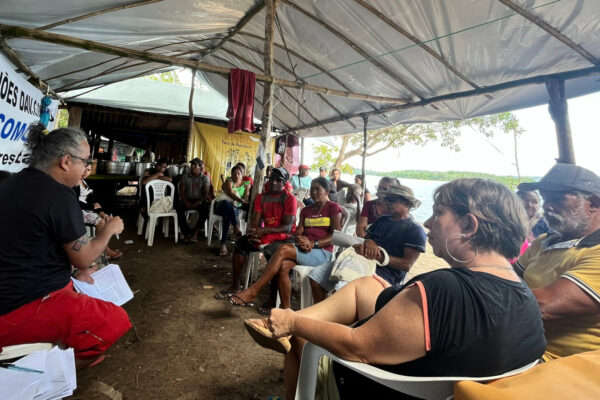The constant battle over Brazil and the world’s largest hydroelectric project in the works took a new turn on Wednesday when hundreds of protestors forced construction of the 11,000-plus megawatt dam to a halt.
Protesters said they would permanently occupy the site, located outside the small jungle city of Altamira in Para state, north Brazil. They called on ally movements to join them.
The Trans-Amazon Highway has been blocked around the Santo Antônio village, where it passes through the construction site, according to Amazon Watch, an NGO that opposes the dam. Groups are demanding the presence of a Brazilian government high-level official at the site to initiate a new round of negotiations respectful of the rights of local people affected by the dam, the NGO said in a press release on Thursday.
“Belo Monte will only succeed if we do nothing about it. We will not be silent. We will shout out loud and we will do it now,” said Juma Xipaia, a local indigenous leader. “We only demand what our Constitution already ensures us: our rights. Many documents and meetings have already transpired and nothing has changed. The machinery continues to arrive to destroy our region.”
Brazil’s government says that it has met with leaders of indigenous tribes various times and has counted on the collaboration of native affairs organizations before agreeing to license the project to private energy consortium Norte Energia last year.
The dam is to be built on the Xingu River in the heart of the Amazon rainforest. Construction was allowed by Ibama, Brazil’s environmental regulation agency, earlier this year and began shortly after. While no indigenous villages will be relocated because of the dam, Ibama said that at least 20,000 people in Altamira and surrounding areas will have to move because of the construction. Indigenous groups like the Xingu River Forever association charge that diverting part of the branches of the Xingu River to form the reservoir that will help power the hydroelectric dam could cause rivers like the Bacajá to dry up, forcing many river dwelling tribes to relocate.
The dam, known as Belo Monte, has been likened by Hollywood’s A-List as Brazil’s Pandora. Mining company Vale (VALE) has roughly a 9% stake in the project. The rest of Norte Energia is comprised mainly of government electric power companies.
Brazil derives most of its electricity from hydroelectric dams, with more than 80% of the country’s power supply coming from its rivers. Right now Brazil is flush with excess electricity, but is expecting to face supply constraints around 2015. The government sees hydroelectric dams as an alternative, non polluting source of power generation. However, to build the dams often cause irreversible environmental damage despite the fact that the mills do not emit harmful CO2 emissions into the atmosphere.
Federal judges in the state of Para have shut down the project with court orders for the past two and a half years, only to have those orders overruled by higher courts in the nation’s capital – Brasilia.
Last Monday, another Para judge declared the dam illegal because the government did not consult with indigenous groups, a charge the Brazilian government vehemently denies. The National Indigenous Foundation, Funai, a representation of indigenous tribes within the government, approved Belo Monte and is part of the ongoing process of constructing the dam.
Brazil’s president at the time Luiz Inacio Lula da Silva met with indigenous groups personally, but many other indigenous groups say that they did not have a proper hearing in Congress, which was required by law under their interpretation of it. However, higher courts have consistently said that their interpretation of the law was wrong, and that the government and Norte Energia gave the public and Para state ample time to voice their opinion on the project before it was approved. The project, which has been on paper for more than a decade, has changed numerous times over the years owning to input from the tribes most affected by the dam’s construction.
One judge says no, another judge says yes…
Moreover, on Thursday, another federal judge in Para, Cristina Demasio, called for the immediate removal of protestors from the region and prohibited any act to disrupt Belo Monte’s construction. The order promises to lead to some police showdown in the state. Anyone caught staying would be obliged to pay R$500 ($285) per day following the order to leave the premises.
Norte Energia said Thursday that the company was complying with local rules and in constant talks with local indigenous groups, adding that it was focused on preserving indigenous lands and their quality of life.
“It’s strange that this group of protestors, most of them not even from Para and led by people with interests contrary to the national interest have occupied Belo Monte resulting in an unnecessary disturbance of public order and intimidation of our workers,” the company said in a press release.
Belo Monte is the largest hydroelectric dam project in the world, but will not be the biggest dam once completed in 2015. The multi-billion dollar dam will be third behind Brazil and Paraguay-owned Itaipu dam and China’s massive Three Gorges Dam, which is nearly as big as Itaipu and Belo Monte combined. Until Three Gorges was completed along the Yangtze River in 2008, Itaipu was the world’s largest with a combined capacity to generate around 14,000 megawatts of electricity. Three Gorges can generate up to 22,500 megawatts of power.













